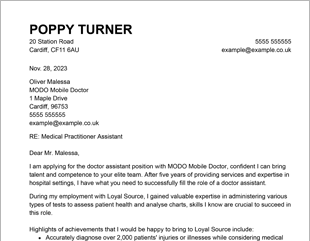What's the Difference? Letter of Interest vs. Cover Letter
There are key differences between a cover letter and a letter of interest. Learn their unique points and in what situations to use them.
There are key differences between a cover letter and a letter of interest. Learn their unique points and in what situations to use them.





OUR USERS HAVE BEEN HIRED BY
Letter of interest or cover letter—it's all the same, right? Well, not really. Both are business letters that can be connected to a job search, but they are commonly deployed at different stages. Though they share many similarities, these documents have different purposes. This handy guide will tell you everything you need to know to avoid mixing the two up!
While a cover letter is a very common document sent alongside a CV with most job applications, a letter of interest is a little less common. Both are addressed directly to the hiring manager or recruiter at a specific company with the goal of securing a new job title. The main difference is in the primary application.
A cover letter is sent in response to a job opening that has been advertised, while a letter of interest can be sent to a company even when there is no job posting. This is because a letter of interest is more of a statement of intent or desire to work for a company than an argument for why you are the best person for a specific job.Â
The main similarity between these two types of letters is the goal of positively representing your skill set and professional experience to impress a prospective employer. Therefore, the same writing tips that can help you create a great cover letter for an open position can help you to create a robust letter of intent.
The basic elements and structure of a letter of interest are similar enough to a cover letter that you could use a cover letter template or online cover letter builder to assist you. The core components are:
If you follow this basic structure you will have a strong, well-rounded letter of intent to send to potential employers. To stand out, focus on your personal and work experience in a way that fits in with the business’s goals and mission. Highlight specific achievements from your years of experience and highlight how you can be of value to prospective employers.
As a bonus tip, if you want to really catch a recruiter’s eye, research and then reference the company culture. Specifically speak to which elements resonate with you and why.
The structure of a cover letter is the same as the one listed above, but the nature of the content held in that structure is different in a cover letter. While a letter of intent is a general introduction from you to potential employers, a cover letter is a structured argument designed to convince a recruiter that you are the best candidate for the specific job they are hiring for.
While a letter of intent should focus on the company and culture of a prospective employer with a brief indication of the value you would bring, a cover letter should focus on what you can offer in a role with the company. Persuasion is the most essential element of a cover letter, and this persuasive element largely centers on your professional skills and achievements.
You can send a letter of interest to a company’s human resources department when you want to put your hat in the ring for future job opportunities, so to speak. This business letter is essentially a way to introduce yourself to a potential employer in the hopes that they will reach out to you when there is an open job that you would be suited to.
A letter of interest should be more general than a cover letter, because you are not responding to an open position. Focus on the company and its culture and highlight why you want to work for them in particular. The relevant company website can provide a lot of contextual information to help you write an effective letter of intent. If available, read through case studies offered on the website to get an idea of their challenges and their methods.
A cover letter is a far more common document than a letter of interest. You can send one in conjunction with any job application. The only exception to this rule is when a job posting specifically states that a cover letter should not be included. When you provide a cover letter via email you should send it as a separate attachment or put it in the body of your email.
Remember that your cover letter should be unique to each application to make the best possible impression.
It is not necessary to send your CV attached to a letter of interest, but it could be helpful as it will provide a more detailed overview of your professional experience and certifications. As you will not have a job description to consider, however, it can be useful to look at example CVs before you submit your CV.
A letter of interest or intent should be short and to the point. The ideal length is between one hundred and fifty and two hundred words. The absolute upper limit is three hundred words.
We personalize your experience.
We use cookies in our website to ensure we give you the best experience, get to know our users and deliver better marketing. For this purpose, we may share the information collected with third parties. By clicking “Allow cookies” you give us your consent to use all cookies. If you prefer to manage your cookies click on the “Manage cookies” link below.